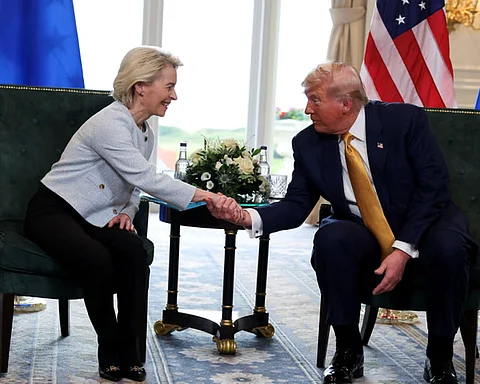

The United States and the European Union have agreed on a new trade framework, ending a prolonged stand-off between two of the world’s largest economic blocs.
The deal was struck following critical negotiations between US President Donald Trump and European Commission president Ursula von der Leyen at Trump’s Turnberry resort in Scotland, UK. As part of the agreement, the US will impose a uniform 15 percent tariff on all EU goods — half the 30 percent rate previously threatened.
In return, the EU will maintain existing tariffs on US imports but will commit to significant American investments, including $750 billion in energy and $600 billion in other capital investments, such as military equipment. These commitments, to be rolled out over three years, are also expected to reduce Europe's dependency on Russian energy sources.
While some goods will be exempt from tariffs — including aircraft and aircraft components, certain chemicals, and select agricultural products — Trump confirmed that a 50 percent tariff on global steel and aluminium imports would remain in place.
Von der Leyen described the agreement as a “huge deal” after what she termed “tough negotiations”, adding that the framework would bring much-needed stability between long-standing allies. Together, the EU and US account for nearly one-third of global trade.
Trump, who is currently on a five-day visit to Scotland, said the agreement would bring both economies “closer together” and hailed it as the “biggest deal ever made”. A separate agreement on semiconductors is reportedly under discussion and may be announced shortly.
While both parties presented the deal as a diplomatic and economic success, questions remain about the precise benefits for the EU. For Brussels, the 15 percent tariff represents a better-than-expected outcome — far less than the 30 percent initially floated, though not as favourable as the UK’s 10 percent rate.
For Washington, the agreement is expected to generate an estimated $90 billion in annual tariff revenue based on 2024 trade volumes, in addition to securing hundreds of billions in inbound investment.
Trump has pursued a tariff-heavy trade policy aimed at reshaping global trade flows and reducing the US trade deficit. Similar bilateral tariff arrangements have been concluded with Japan, Vietnam, Indonesia, the Philippines, and the UK, although his broader goal of “90 deals in 90 days” remains unmet.
European leaders responded cautiously to the agreement. Ireland’s Taoiseach, Micheál Martin, noted that while the deal avoids a damaging trade war, it will still result in higher costs and complexity for cross-Atlantic trade. Ireland remains the most export-dependent EU economy on the US market.
German Chancellor Friedrich Merz said Germany, a major goods exporter, had much to lose in a tariff conflict, and welcomed the new stability. Italian Prime Minister Giorgia Meloni also backed the deal in principle but reserved full judgement until further details are released.
Had the deal not materialised, European products ranging from pharmaceuticals and electronics to cheese and leather would have faced steep tariffs. The EU, in turn, had prepared retaliatory duties on American cars, beef, and aerospace goods.
For now, both sides have stepped back from the brink — but as observers note, the full impact of this “historic deal” will depend on the finer details yet to be released.